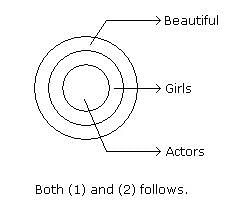EMRS TGT Hindi Mock Test - 3 - EMRS MCQ
30 Questions MCQ Test - EMRS TGT Hindi Mock Test - 3
Van der Waal’s equation is related to which of the behaviour of which of the following?
| 1 Crore+ students have signed up on EduRev. Have you? Download the App |
Saturated carbon compounds can form which types of chain structures?
I. Straight chain
II. Branched-chain
Which of the cells of connective tissue secrete antibiotics?
Which is the first ever comic book launched by WWF-India ?
Which of the following properties are exhibited by the covalent compounds?
I. Have high boiling and melting point as compared to ionically bonded molecules
II. Are poor conductors of electricity.
III. Have weak inter-molecular force.
In the following question assuming the given statements to be True, find which of the conclusion among given conclusions is/are definitely true and then give your answers accordingly.
Statement:
P > S ≥ M = L < J = N
Conclusions:
I. L < N
II. P > M
III. S = L
Statements:
All the actors are girls.
All the girls are beautiful.
Conclusions:
1. All the actors are beautiful.
2. Some girls are actors.
Statements:
All the harmoniums are instruments.
All the instruments are flutes.
Conclusions:
(1) All the flutes are instruments.
(2) All the harmoniums are flutes.
Kamali walks a distance of 3m towards North then turns to her left and walk for 2m.She turns left and walks for 3m.At this point she turns to his left and walk for 3m.How many metres is she from the starting point ?
One day afternoon Arun and Mani were sitting in a garden and facing each other.Mani’s shadow fall exactly towards Arun’s right, Which direction was Mani facing ?
P is 15m to the west of Q. R is 13m to the south of Q and 5m to the east of S. T is 20m to the north of S.T is 10m to the east of U…….
Q.
In which direction R with respect to P
If southeast become North, North-east become West and so on.What will be the West ?
N is more intelligent than M. M is not as intelligent as Y. X is more intelligent than Y but not as good as N. Who is the most intelligent of all ?
Q. In a queue, Rahul is fourteenth from the front and John is seventeenth from the end, while Alisha is in between Rahul and John. There are 48 persons in the queue, how many persons are there between Rahul and Alisha?
The _____________ enables you to simultaneously keep multiple web pages open in one browser window.
The following is not a part of the clinical method :
A psychologist studied the individuals and compared the jobs they were employed in. Which method was he using :
Which of the following applies to the experimental method?
Appreciation, love and affection are part of the following needs of a child.
निम्नलिखित गद्यांश को ध्यानपूर्वक पढ़िए और पूछे गए प्रश्नों के उत्तर दीजिए।
विधाता-रचित इस सृष्टि का सिरमौर है मनुष्य। उसकी कारीगरी का सर्वोत्तम नमूना! इस मानव को ब्रह्याण्ड का लघु रूप मानकर भारतीय दार्शनिकों ने ‘यत् पिण्डे तत् ब्रह्याण्डे’ की कल्पना की थी। उनकी यह कल्पना मात्र कल्पना नहीं थी, प्रत्युत यथार्थ भी थी, क्योंकि मानव-मन में जो विचारणा के रूप में घटित होता है, उसी का कृति रूप ही तो सृष्टि है। मन तो मन, मानव का शरीर भी अप्रतिम है। देखने में इससे भव्य, आकर्षक एवं लावण्यमय रूप सृष्टि में अन्यत्र कहाँ है! अदभुत एवं अद्धितीय है मानव-सौन्दर्य! साहित्यकारों ने इसके रूप-सौन्दर्य के वर्णन के लिए कितने ही अप्रस्तुतों का विधान किया है और इस सौन्दर्य-राशि से सभी को आप्यायित करने के लिए अनेक काव्य-सृष्टियाँ रच डाली हैं। साहित्यशास्त्रियों ने भी इसी मानव की भावनाओं का विवेचन करत हुए अनेक रसों का निरूपण किया है, परन्तु वैज्ञानिक दृष्टि से विचार किया जाए तो मानव-शरीर को एक जटिल यन्त्र से उपमित किया जा सकता है। जिस प्रकार यन्त्र के एक पुर्जें में दोष आ जाने पर सारा यन्त्र गड़बड़ा जाता है, बेकार हो जाता है; उसी प्रकार मानव-शरीर के विभिन्न अवयवों में से यदि कोई एक अवयव भी बिगड़ जाता है तो उसका प्रभाव सारे शरीर पर पड़ता है। इतना ही नहीं, गुर्दे जैसे कोमल एवं नाजुक हिस्से के खराब हो जाने से यह गतिशील वपु-यन्त्र एकाएक अवरूद्ध हो सकता है, व्यक्ति की मृत्यु हो सकती है। एक अंग के विकृत होने पर सारा शरीर दण्डित हो, वह कालकवलित हो जाए-यह विचारणीय है यदि किसी यन्त्र के पुर्जे को बदलकर, उकसे स्थान पर नया पुर्जा लगाकर यन्त्र को पूर्ववत् सुचारू एवं व्यवस्थित रूप से क्रियाशील बनाया जा कसता है तो विकृत अंग के स्थान पर नव्य निरामय अंग लगाकर शरीर को स्वस्थ एवं सामान्य क्यों नहीं बनाया जा सकता? शल्य-चिकित्सकों ने इस दायित्वपूर्ण चुनौती को स्वीकार किया तथा निरन्तर अध्यवसाय पूर्णसाधना के अनन्तर अंग-प्रत्यारोपण के क्षेत्र में सफलता प्राप्त की। अंग-प्रत्यारोपण का उद्देश्य है कि मनुष्य दीर्घायु प्राप्त कर सके। यहाँ यह ध्यातव्य है कि मानव-शरीर हर किसी के अंग को उसी प्रकार स्वीकार नहीं करता, जिस प्रकार हर किसी का रक्त उसे स्वीकार्य नहीं होता। रोगी को रक्त देने से पूर्व रक्त-वर्ग का परिक्षण अत्यावश्यक है तो अंग-प्रत्यारोपण से पूर्व ऊतक-परीक्षण अनिवार्य है। आज का शल्य-चिकित्सक गुर्दे, यकृत, आँत, फेफड़े ओर हृदय का प्रत्यारोपण सफलतापूर्वक कर रहा है। साधन-सम्पन्न चिकित्सालयों में मस्तिष्क के अतिरिक्त शरीर-समपन्न चिकित्सालयों में मस्तिष्क के अतिरिकत शरीर के प्रायः सभी अंगों का प्रत्सारोपण सम्भव हो गया है।
प्रश्न: शल्य-चिकित्सकों का मूल ध्येय है-






















